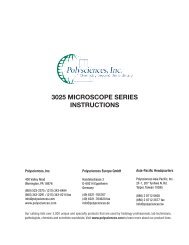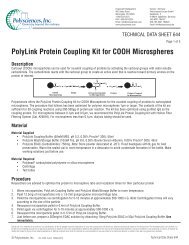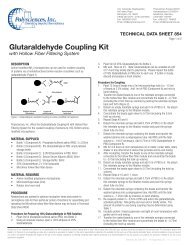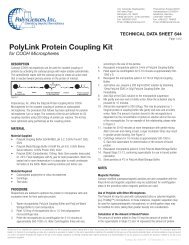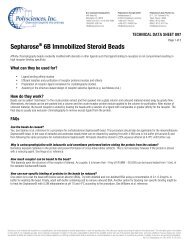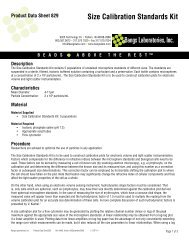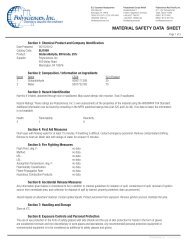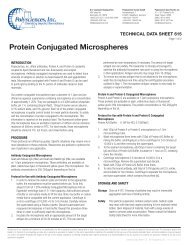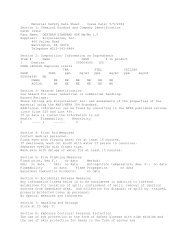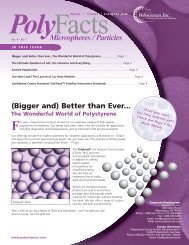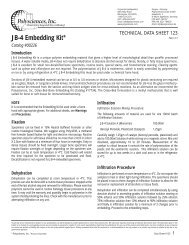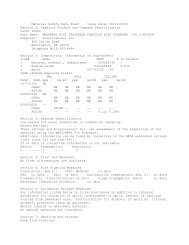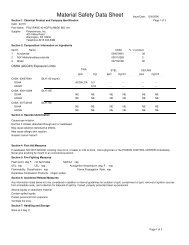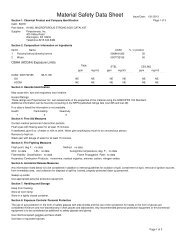Monomers Product Guide - Polysciences, Inc.
Monomers Product Guide - Polysciences, Inc.
Monomers Product Guide - Polysciences, Inc.
You also want an ePaper? Increase the reach of your titles
YUMPU automatically turns print PDFs into web optimized ePapers that Google loves.
<strong>Monomers</strong><br />
Catalog #<br />
Amine Containing <strong>Monomers</strong><br />
Amines are among the most widely versatile functional groups. In biopolymers, amines are the key synthetic handle to build structure<br />
and architecture to a polymer. Amine groups can act as base catalysts, can be quaternized to yield aqueous soluble polymers and can<br />
function as ligands to a variety of metals. Amines are good nucleophiles and can be converted to a wide set of functional groups.<br />
Amines can form salts with carboxylic and phosphoric acids to form biologically interesting complexes and structures.<br />
Size<br />
2-Acryloxyethyltrimethylammonium<br />
chloride<br />
2-Aminoethyl methacrylate<br />
hydrochloride, min. 95%<br />
N-(2-aminoethyl) methacrylamide<br />
hydrochloride<br />
N-(t-BOC-aminopropyl)<br />
methacrylamide<br />
N-(3-Aminopropyl)methacrylamide<br />
hydrochloride, >98%<br />
2-(tert-Butylamino)ethyl methacrylate,<br />
min. 90%<br />
Polymerizable<br />
Sites<br />
Polymerization<br />
Synthon<br />
Add’l. Reactive<br />
Functionality<br />
mono acrylic quaternary,<br />
HCI salt<br />
mono acrylic primary,<br />
HCI salt<br />
mono acrylic secondary,<br />
HCI salt<br />
mono acrylic primary<br />
(protected)<br />
mono acrylic primary,<br />
HCI salt<br />
Special Features<br />
solvent soluble,<br />
for primary amine<br />
polymers<br />
mono acrylic secondary homopolymer<br />
Tg = 33º C<br />
17981-250 250 g 128<br />
21002-10 10 g 129<br />
24833-5 5 g 129<br />
24318-10 10 g 129<br />
21200-5 5 g 129<br />
01797-100 100 g 134<br />
Diallylamine, min. 98% dual vinyl secondary forms cyclopolymers 21424-100 100 g 137<br />
Diallyldimethylammonium chloride, dual vinyl quat cationic polymers via 15912-100 100 g 137<br />
65% soln. in water<br />
cyclopolymerization<br />
2-(N,N-Diethylamino)ethyl<br />
methacrylate<br />
2-(Diethylamino)ethylstyrene, mixed<br />
m,p-isomers, min. 95%<br />
mono acrylic tertiary homopolymer<br />
Tg = 20º C<br />
01872-500 500 g 137<br />
mono vinyl tertiary 24100-5 5 g 137<br />
2-Diisopropylaminoethyl methacrylate mono acrylic tertiary 24263-10 10 g 138<br />
2-(N,N-Dimethylamino)ethyl acrylate mono acrylic tertiary 02257-500 500 g 138<br />
N-[2-(N,N-Dimethylamino)ethyl] mono acrylic tertiary hydrolytic stability 06172-5 5 g 138<br />
methacrylamide<br />
N-[3-(N,N-Dimethylamino)propyl]<br />
acrylamide, min.95%<br />
N-[3-(N,N-Dimethylamino)propyl]<br />
methacrylamide<br />
mono acrylic tertiary homopolymer<br />
Tg = 19º C<br />
22018-10 10 g 138<br />
mono acrylic tertiary hydrolytic stability 09656-100 100 g 139<br />
3-Dimethylaminoneopentyl acrylate mono acrylic tertiary 17970-10 10 g 139<br />
2-(N,N-Dimethylamino)ethyl<br />
mono acrylic tertiary homopolymer 00213-500 500 g 138<br />
methacrylate, min. 99%<br />
Tg = 19º C<br />
Methacryloyl-L-Lysine mono acrylic amino acid zwitterionic,<br />
multifunctional,<br />
water soluble<br />
24315-5 5 g 149<br />
2-N-Morpholinoethyl acrylate, 95% mono acrylic tertiary 17977-100 100 g 150<br />
2-N-Morpholinoethyl methacrylate, mono acrylic tertiary 17978-100 100 g 150<br />
95%<br />
6<br />
For more information please call (800) 523-2575 or visit: polysciences.com



